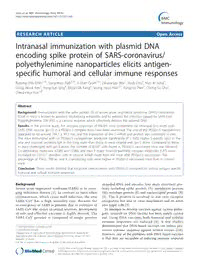
2010 Intranasal immunization with plasmid DNA encoding spike protein of SARS-coronavirus_polyethylenimine nanoparticles PDF
Preview 2010 Intranasal immunization with plasmid DNA encoding spike protein of SARS-coronavirus_polyethylenimine nanoparticles
RESEARCH ARTICLE Open Access Intranasal immunization with plasmid DNA encoding spike protein of SARS-coronavirus/ polyethylenimine nanoparticles elicits antigen- specific humoral and cellular immune responses Byoung-Shik Shim1,3†, Sung-Moo Park2,3†, Ji-Shan Quan1,4†, Dhananjay Jere1, Hyuk Chu5, Man Ki Song3, Dong Wook Kim3, Yong-Suk Jang6, Moon-Sik Yang6, Seung Hyun Han3,7, Yong-Ho Park2, Chong-Su Cho1, Cheol-Heui Yun1,8* Abstract Background: Immunization with the spike protein (S) of severe acute respiratory syndrome (SARS)-coronavirus (CoV) in mice is known to produce neutralizing antibodies and to prevent the infection caused by SARS-CoV. Polyethylenimine 25K (PEI) is a cationic polymer which effectively delivers the plasmid DNA. Results: In the present study, the immune responses of BALB/c mice immunized via intranasal (i.n.) route with SARS DNA vaccine (pci-S) in a PEI/pci-S complex form have been examined. The size of the PEI/pci-S nanoparticles appeared to be around 194.7 ± 99.3 nm, and the expression of the S mRNA and protein was confirmed in vitro. The mice immunized with i.n. PEI/pci-S nanoparticles produced significantly (P < 0.05) higher S-specific IgG1 in the sera and mucosal secretory IgA in the lung wash than those in mice treated with pci-S alone. Compared to those in mice challenged with pci-S alone, the number of B220+ cells found in PEI/pci-S vaccinated mice was elevated. Co-stimulatory molecules (CD80 and CD86) and class II major histocompatibility complex molecules (I-Ad) were increased on CD11c+ dendritic cells in cervical lymph node from the mice after PEI/pci-S vaccination. The percentage of IFN-g-, TNF-a- and IL-2-producing cells were higher in PEI/pci-S vaccinated mice than in control mice. Conclusion: These results showed that intranasal immunization with PEI/pci-S nanoparticles induce antigen specific humoral and cellular immune responses. Background Severe acute respiratory syndrome (SARS) is an emer- ging infectious disease [1]. In contrast to most other coronaviruses, which cause mild infection, the new SARS-CoV has a high mortality rate. Because the re-emergence of SARS is possible due to existence of SARS-CoV like strains in animal reservoir, development of safe and effective vaccines is highly desired. The SARS-CoV genome is composed of single positive stranded RNA and encodes four main structural pro- teins including spike protein (S), membrane protein (M), envelope protein (E) and nucleocapsid protein (N) [2]. The S protein is involved in not only receptor recognition but also in virus attachment and its entry into target cells [3]. In attempts to develop vaccines against various patho- gens, research on DNA vaccine has been widely carried out. Using DNA vaccines, both humoral and cellular immune responses are induced [4]. A few studies demonstrated that DNA-based vaccines can induce pro- tective immune response against several viruses [5,6]. However, one of the problems with DNA-based vaccines is that they are incapable of inducing immune response * Correspondence:
